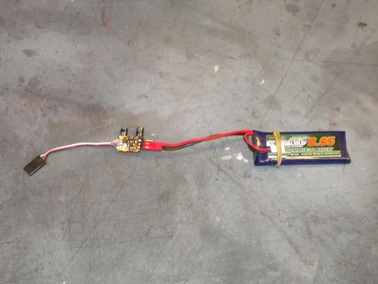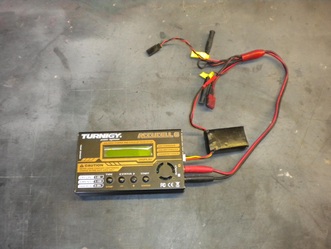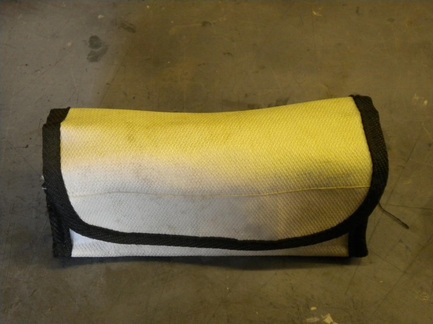THE SAFE AND EFFECTIVE USE OF
LITHIUM POLYMER BATTERIES
IN MODEL YACHT SAILING.
By PGS Jackson

This document is intended to provide a set of guidelines for sailors who wish to use Lithium Polymer (LiPo) batteries in model yachts and associated equipment. It has been written mainly to emphasise the safety aspects, but also contains information and guidance regarding their usage on a day to day basis.
A cell is a single sealed unit containing an anode, a cathode, and the electrolyte. It has a voltage dependent upon the electro chemistry of the materials used, and in the case of a LiPo cells this is a mean voltage of 3.7V. To achieve higher voltages, single cells are assembled into a series of wired sets, and these are called batteries. The number of cells in a battery is designated by a simple number and the letter S for series, so that a 2S battery or pack has two cells and has a total mean voltage of 7.4V.
For model yacht use there will not be any advantage for using a higher S rated pack other than 1S or 2S cells.
The 2S cells may be used in Transmitters if the manufacturer has approved their use in his equipment, and on winches more commonly used in one meter yachts. Some older transmitters may require a 3S battery to bring it above the 9.6V for say a Nichol Metal Hydride equivalent, but again only if the manufacturer approves.
However this document is written with Footy Yachts in mind and there should not be any need to use anything other than a 1S battery connected to a voltage booster that will bring the output up to 5V just to power the receiver and servos. A typical battery and voltage booster are shown.
A cell is a single sealed unit containing an anode, a cathode, and the electrolyte. It has a voltage dependent upon the electro chemistry of the materials used, and in the case of a LiPo cells this is a mean voltage of 3.7V. To achieve higher voltages, single cells are assembled into a series of wired sets, and these are called batteries. The number of cells in a battery is designated by a simple number and the letter S for series, so that a 2S battery or pack has two cells and has a total mean voltage of 7.4V.
For model yacht use there will not be any advantage for using a higher S rated pack other than 1S or 2S cells.
The 2S cells may be used in Transmitters if the manufacturer has approved their use in his equipment, and on winches more commonly used in one meter yachts. Some older transmitters may require a 3S battery to bring it above the 9.6V for say a Nichol Metal Hydride equivalent, but again only if the manufacturer approves.
However this document is written with Footy Yachts in mind and there should not be any need to use anything other than a 1S battery connected to a voltage booster that will bring the output up to 5V just to power the receiver and servos. A typical battery and voltage booster are shown.

The first important feature of LiPo cells is that the cell voltage can vary between 2.8V up to 4.2V. If the cell is discharged below 2.8V then permanent damage can occur and the cell will not regain is maximum capacity. Similarly if the cell is overcharged above 4.2V then the cell will become hot and may burst in flame. This is known as a chemical fire and it can not be extinguished as the reaction contains it's own oxygen from the electrolyte.
The transmitter may also be powered by a LiPo battery but typically this will have two cells and there will be a charging connector (thick wires), which when in use is connected to the transmitter, and a balance connector in this case with three wires and a smaller connector that is used solely in the charging process, to make sure the voltages of both cells are the same.
The capacity of the cell or battery is usually quoted in milliampere hours (mAh), we also need to be aware of what is called the C rating, and it changes with different types and manufacturers. A 1C rating is equivalent to a complete discharge (or charge) in one hour so that the current draw will be the Ah capacity numerically expressed in Amps. It is best to stick to the 1C charge rating for all batteries as this should not reduce the life unduly. So for a 950mAh cell charged at 1C would be just under one amp, so the nearest charge rate on the charger would be 1A. Charging of LiPo batteries can only be carried out with a charger specifically designed to charge LiPo cells.
Charging should only be carried out with the voltage booster disconnected and the charger will stop the process when the cell voltage reaches 4.2V. The cell should be slightly warm during the process, if it gets very warm then the process should be terminated. Charging should be carried out in an area free from materials that could easily catch fire should there be a problem with the cell. Another sign of concern is if the cell starts to look puffy, that is increasing in size, again the process should be immediately stopped. The cells should then be quarantined and disposed of safely, by taking them to your local waste cycling centre.
If you are using a 2S cell then it should be balanced charged and this should be selected on your charger with both the main and balanced lead connected to your charger. Again if you are charging you can select the third button from the left side (usually) and this will indicate each cell voltage and the process should stop automatically when each cell stabilises at 4.2V.
Never leave your cells charging unattended.
Ambient temperatures will also effect the performance of the battery pack, that is if the temperature is low the cell will not deliver as much power as when the temperature is a little warmer, however with the set up used in Footys this is not considered to be a major problem, but needs to be born in mind as to when to change cells. Remember you need to change cells before the lower limit is reached, or there will be damage that cannot be repaired by charging
The transmitter may also be powered by a LiPo battery but typically this will have two cells and there will be a charging connector (thick wires), which when in use is connected to the transmitter, and a balance connector in this case with three wires and a smaller connector that is used solely in the charging process, to make sure the voltages of both cells are the same.
The capacity of the cell or battery is usually quoted in milliampere hours (mAh), we also need to be aware of what is called the C rating, and it changes with different types and manufacturers. A 1C rating is equivalent to a complete discharge (or charge) in one hour so that the current draw will be the Ah capacity numerically expressed in Amps. It is best to stick to the 1C charge rating for all batteries as this should not reduce the life unduly. So for a 950mAh cell charged at 1C would be just under one amp, so the nearest charge rate on the charger would be 1A. Charging of LiPo batteries can only be carried out with a charger specifically designed to charge LiPo cells.
Charging should only be carried out with the voltage booster disconnected and the charger will stop the process when the cell voltage reaches 4.2V. The cell should be slightly warm during the process, if it gets very warm then the process should be terminated. Charging should be carried out in an area free from materials that could easily catch fire should there be a problem with the cell. Another sign of concern is if the cell starts to look puffy, that is increasing in size, again the process should be immediately stopped. The cells should then be quarantined and disposed of safely, by taking them to your local waste cycling centre.
If you are using a 2S cell then it should be balanced charged and this should be selected on your charger with both the main and balanced lead connected to your charger. Again if you are charging you can select the third button from the left side (usually) and this will indicate each cell voltage and the process should stop automatically when each cell stabilises at 4.2V.
Never leave your cells charging unattended.
Ambient temperatures will also effect the performance of the battery pack, that is if the temperature is low the cell will not deliver as much power as when the temperature is a little warmer, however with the set up used in Footys this is not considered to be a major problem, but needs to be born in mind as to when to change cells. Remember you need to change cells before the lower limit is reached, or there will be damage that cannot be repaired by charging

It is recommended that spare cells be stored and carried in a fireproof bag, a picture of which is shown.
Other sources of fires are the shorting of the cables due to the insulation main around the connectors, so be aware and regularly inspect your wiring harness.
Other sources of fires are the shorting of the cables due to the insulation main around the connectors, so be aware and regularly inspect your wiring harness.

